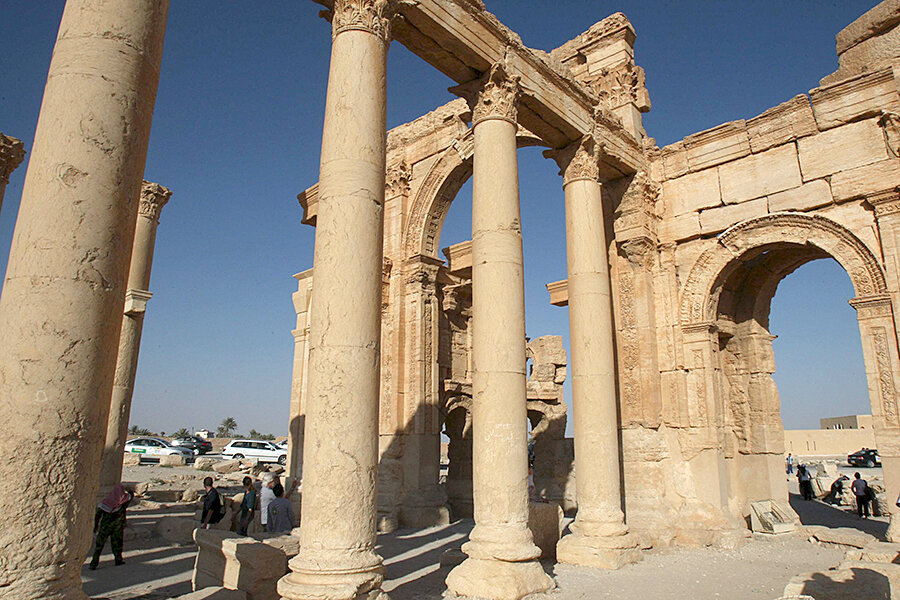Islamic State seizes ancient Palmyra for strategic boost in eastern Syria
Loading...
| Istanbul, Turkey
Islamic State militants were in full control of the ancient city of Palmyra in central Syria Thursday, residents said, a victory that gave them a strategic and symbolic boost less than a week after the group seized the Iraqi city of Ramadi.
This fresh victory has turned the militant group into the dominant force in more than half of Syria, according to one activist group, and raised fears over the fate of its monumental ruins. Military analysts said the IS victory deprived the Syrian Army of an important local “anchor” and put IS forces in control of an important crossroads in eastern Syria that could open new supply lines to Iraq.
On Wednesday, IS fighters had seized the city’s intelligence headquarters, hospital, airport, a key checkpoint at the heart of the city that was traditionally guarded by tanks, as well a military police interrogation center.
By Thursday, residents reached on social media confirmed IS’s grip and said it was clearing the area of regime supporters, with one shared image showing the decapitated bodies of young men at the old courthouse.
A Palmyra resident contacted by telephone said: “Today they started eliminating regime supporters. The streets are filled with the smell of death and dismembered bodies.”
Palmyra is where Queen Zenobia defied the Roman Empire in the 3rd century, a point of pride for locals and a salient trope in nationalist discourse. Unlike the mythical queen, however, forces loyal to President Bashar al-Assad made no grand last stand in the desert outpost this week, their military vehicles slinking away in the face of an IS onslaught that was months in the making.
Quick retreat spurs fears
The retreat was so swift that activists there fear the regime is planning to unleash a barrage of its signature barrel bomb or chemical attacks.
“The fate of the people of Palmyra lies somewhere between the daggers of IS and the barrel bombs of the regime,” said a female activist using the handle of Ayn Tadmur, the song of caged birds and sporadic bombing punctuating her audio message.
Modern Palmyra is a relatively small desert city, with a pre-conflict population of roughly 60,000 people, but its fall to IS represents a significant blow to the regime, analysts say.
“The symbolic significance is huge for the ruins and for the prison that used to be there,” says Aron Lund, editor of Syria in Crisis, a website run by the Carnegie Endowment for International Peace. “That could have a military effect in and of itself. Now they are showing that they are growing and getting closer to Damascus and Homs."
Crossroads key to supply lines
The Syrian Army “lost the anchor that was holding down their forces in that central desert area of Syria,” adds Mr. Lund.
“It brings IS to a true geographic crossroads in the east,” emphasizes Jeffrey White, a defense fellow at the Washington Institute for Near East Policy. “It gives IS a number of military options to carry the offensive forward.”
Palmyra straddles a strategic road network that could eventually allow IS to secure new supply lines all the way from its strongholds in Iraq to southern Syria, while cutting the regime's supply line to Deir Ezzor, where it is holding on to its last military garrison.
The latest defeat comes in the wake of significant loss of territory in Idlib Province. Government weapons depots in Palmyra have also fallen into IS hands, giving them ammunition to fuel fresh offensives.
“It represents a pretty significant military change and it could be another one of those so-called turning points in the war,” says Mr. White. “We have to see how the regime responds. If it decides to consolidate and pull back to areas that are of critical importance to them, then [the regime] can continue. If IS continues its offensive towards the West,” he notes, “there is an increasing likelihood that they will run into Hezbollah.”
Vital assets in area
Control over Palmyra also bring vital assets – such as two gas fields in the area and the T4 military airbase – closer to within IS reach, White says. Syrian opposition sources with strong ties to Palmyra say the two gas fields fell already, along with the Tadmur airport, in the first stage of the offensive, but that claim could not be independently confirmed.
Another question mark surrounds the fate of prisoners held in the notorious Tadmor prison, with some activists reporting that it was empty when IS forces took it. The Sunni militants did release a number of prisoners held in the intelligence HQ, residents said.
Given the geography of the area, it will be difficult for the regime to overturn its losses. “It is interesting to see how the US handles this. Maybe it will be easier for the US to target IS if Assad is gone from there, but on the other hand they have no ground force whatsoever in that area,” says Lund.
Asked what were the chances that the US might step in as it did in the Syrian Kurdish town of Kobane, where the international anti-IS coalition found the Kurds to be reliable partners on the ground, White said: “Zero.”





